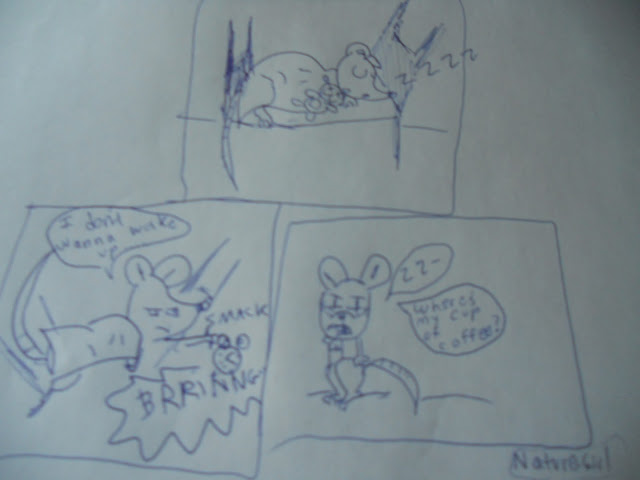Your bunny has specific grooming needs that you have to fulfill every month. To start, put your bunny on a table and get ready to groom!
Get a Head Start
Your bunny's face and head is very important. Eyes and ears catch build-up, and teeth need to be checked for overgrowth.
Eyes
Carefully look at eyes. Get a dry washcloth and gently wipe away any crusty "sleep" that had built up in their eyes. Yellow or white is normal, but dry blood or black, brown, or green ooze is very bad. Immediately contact the vet.
Test the eyes by pretending to poke the eye. If the rabbit blinks, he has good eyesight. But if he does not blink, you should probably know that this means blindness.
Nose and Ears
Gently look up the nose and into the ears. With a cotton swab, CAREFULLY swipe out any "earwax" into view. This means only the area you can see. NEVER, and I mean never, put the cotton swab into the base of the ear. This could fall down and get stuck, cause irritation, or burst the eardrum.
Mouth
Most rabbits don't like for their mouth to be opened by someone else, but it has to be done. Pull the lips aside gently to see the teeth. Examine them for decay, chipping, overgrowth, bleeding, and then see the other set of teeth. Check the gums for abscesses(they look like white bumps with fleshy spots) and cuts obviously caused by long teeth. Be sure to reward your pet with a treat for good behavior.
Best Foot Forward
Feet on a rabbit can be very delicate. Toes and nails should be checked with care.
Nails
Nails on rabbits grow quickly. Rabbits with curled-in nails cannot walk and will get arthritis. Lay the rabbit in a cradling position. If he feels more comfortable curled in a towel, this is also fine. (Daisy does better sitting for her front paws and I simply lift each paw! This probably won't work for your bunny) Start by trimming each toenail. Remember to avoid the quick(The pink/dark vein in the nail.) since it hurts them if it is exposed. Styptic powder helps this problem. Since Daisy's nails are dark, a flashlight really helps to see the quick! When you are done, carefully file the nails to make them less rough and then, if you like, use a wet cotton ball or swab to clean off any debris.
Toes and paws
Check toes to make sure there are not any cuts. Front and back paws need a special amount of steps. First, check for baldness on the feet. Make sure there is no Sore Hocks(A minor foot disease caused by rubbing against wire bars and sitting in urine). You can determine this by baldness, dried blood, and/or purplish-red bumps all on the back feet. Treat this with Neosporin and contact the vet to give tips and possible treatments for the feet. Use a wet cotton ball to clean off the feet if there is dirt and/or dry feces and urine.
Just Fur You
Time to brush the fur! You will need most of these combs and brushes on hand: (Ask vet about long-haired rabbits) Tip: Rabbit's tummies do not need to be brushed. It is a sensitive area that can hurt them. Plus, most "belly fur" comes off during normal activities.
- Rubber Comb
- Slicker Brush
- Flea Comb(optional)
- Cat Brush
- Bristle Brush
- FURminator (optional)
- Blunt Scissors(for long fur)
First of all, start by using the bristle brush. Skim the fur with this brush. Use this brush to carefully groom the head.
Next, use the rubber comb to stroke down the back. Do this for a while until it seems to have gotten cleaned up.
Use the flea comb to search through the fur for any parasites.
Use the slicker brush to brush the fur.
Now use the cat brush(usually curved) to comb out all the fur.
Use your hand to slide down the rabbits back to make sure you have combed and brushed the fur well.
REMEMBER TO NEVER BATHE YOUR BUNNY! THIS COULD RESULT IN SERIOUS CONSEQUENCES TO YOU AND YOUR RABBIT.
The End
Finally you have to check the tail.
Tail
Urine and feces can get stained in the fur on and around the tail. Use a wipe to remove major stains in the fur.
Scent Glands
The scent glands under a rabbit's chin don't need to be cleaned, but there are two that do. They are located near the tail, close to the genitals. There can be a build-up here, so it is recommended they should be cleaned every time you do your daily grooming routine. Rabbit's scent glands look like a pocket in the skin. When clogged up, they have dark residue stuck in them. Sometimes bits of dried urine and feces can get in here too, so it's and added bonus to clean these out. Get a cotton swab and put warm water on it. With your rabbit cradled between your knees, loosen the debris by gently holding it open between two fingers. Rabbits normally don't like this,(who would?) so remember to give him a special snack or treat when you are done. He probably deserves it!!

